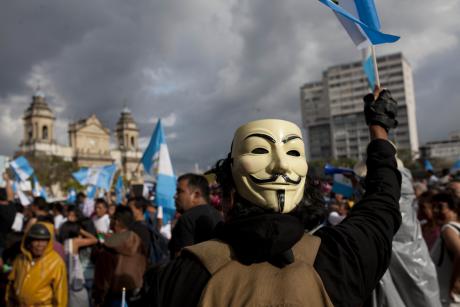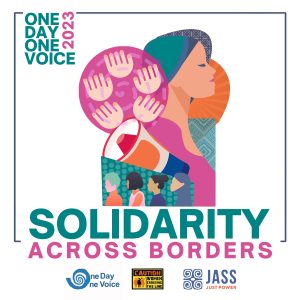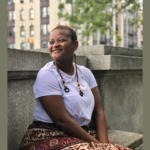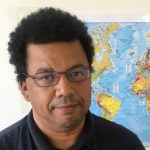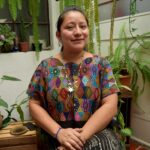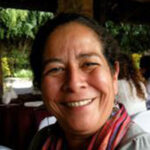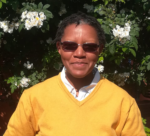When we think of democracy, we tend to envision a political and social model in which citizens are able to use representative tracks to channel their aspirations and proposals; in which the state responds to their demands, protects their rights and translates them into concrete policies and programs aimed at increasing both their private and public wellbeing; in which the state ensures that justice benefits everyone equally, and in which the people can participate in the decisions that affect their daily lives. That experience of democracy seems like a distant dream for Guatemalans who have lived through military dictatorships, civil war and violence.
But, in August 2015, Guatemala, a country of approximately 16 million people, mostly women and indigenous people, were stunned by the announcement of the arrest of President Otto Pérez Molina’s and his Vice President Roxana Baldetti. The two were accused and charged with running a large network of customs-related corruption scheme that left the public coffers empty and prompted a severe financial crisis.
The general feeling was one of triumph: by keeping up the pressure in the streets, the Guatemalan people managed to overthrow the president and vice president and open up a new era for democracy in the country. The international media sent the message around the world that Guatemala was a democratic example for Latin America and the world – a Latin American version of the Arab Spring.
Guatemala’s demonstrations against corruption – an interpretation
Since April of 2015, social networks had been coordinating a powerful campaign demanding the Vice President’s resignation first, and then the President’s. In Guatemala City’s central square, crowds of up to 70.000 people gathered each week to protest and demand an end to corruption. Guatemala was coming out of its lethargy and apparent indifference, particularly among the middle classes, and standing up against the unbridled corruption in all spheres of government and the metastasis of organized crime in state structures.
Since the signing of the Peace Accords in 1996, after 36 years of internal armed conflict, the country had not seen nor felt such a massive expression of public feeling in the capital city, the epicenter of political power. The armed conflict, one of the bloodiest and most silenced in Latin America, left a legacy of terror and impunity in the country. And silence continued to be the preferred language of the political and economic elite which maintained its power and privileges on the basis of one of the highest inequality rates in the continent.
The demonstrations – mainly in Guatemala City, but also in other major cities – featured some elements that were unprecedented in Guatemala’s grassroots movements, particularly on this scale. First, they were called for through social media networks, by ordinary people (a housewife outraged by impunity and indifference sent out the first call, so the story goes). Second, they brought together especially, but not exclusively, the urban middle classes. Third, mostly young men and women from a revitalized student movement were in the lead. Four, although leaders of “historical” social organizations took part in the demonstrations, they did so as citizens, without their own flags. Five, the movement broke down the barriers between the middle classes and other sectors of the population with whom the former did not have much contact, notably the indigenous population, which has been traditionally segregated by pervasive racism in the Guatemalan society. And although it was not involved from the outset, the country’s powerful business sector eventually came out to demonstrate in the streets demanding the president’s resignation. Given the profound class and ethnic stratification that characterizes Guatemala since its colonial times, the voices from all these sectors chanting together “The people united will never be defeated” was quite surreal.
However, in many different parts of the country, indigenous peoples, women, and rural workers had been protesting for years, marching and mobilizing for the recognition of their right of access to land, healthcare, and education. But their voices went unheard. At best, successive governments momentarily yielded to the pressure, only to break later on the promises made. During all these years, Guatemala held formal dialogues that revealed, yet again, the unequal distribution of power between the dominant sectors and the vast majority.
Many, diverse and sometimes motivated by conflicting interests: these were the factors that came into play – and, this time, the voices of discontent were finally heard.
Diverse factors
In 2006, under pressure from several human rights organizations, the government of Guatemala accepted the establishment of a UN Commission against Impunity in Guatemala – the CICIG. Its mandate was to focus on investigating paradigmatic cases of human rights violations and on strengthening the judiciary in fighting impunity. The commission uncovered major cases of violations during the armed conflict, including genocide, which led to the conviction of General – and former president – Efraín Rios Montt. As a result, the commission was attacked and maligned by conservatives and nationalists on the basis of the principle of non-interference in internal affairs by international organizations. Following the demonstrations and the imprisonment of the former president and vice president, the current head of the CICIG became an icon of the fight against corruption in the country, along with Attorney General Thelma Aldana, who has been consistently and explicitly backed by the CICIG. The CICIG publicly stated its support of the anti-corruption demonstrations throughout, and continues to do so today, as the demonstrations flare up again, albeit with much less belligerence.
For its part, the US Embassy openly expressed its support for the citizens’ mobilization against corruption and pushed for the resignation of the Vice President and the President. As time passes, the role of the United States became increasingly clear, and so too its motivations. The historical migration flows to the US from the region, and the added embarrassment arising from allegations of the mistreatment of migrant children; the positioning of Pérez Molina at an OAS forum in favor of legalizing drugs; and the need to create a climate of stability in the so-called Northern Triangle of Central America (Guatemala, El Salvador and Honduras) to boost its “Alliance for Prosperity” plan – these are all key factors to ensure a relatively safe climate for US investments in the region, and to help offset the large investments by China and Russia in infrastructures and extractive projects.
This was happening on the eve of the September 2015 elections in Guatemala. Some sectors, including feminist organizations, asked for the elections to be cancelled since the minimal democratic conditions for the holding elections could not be guaranteed until the Electoral Law and the Law of Political Parties were reformed. But the electorate felt strong and ready to topple a President, and in that spirit turned out to vote for a candidate whose campaign slogan was “Neither corrupt, nor thief”. And this was how Jimmy Morales, a television and radio comedian, became Guatemala’s new president.
Progress and limitations in the courts
In recent months, Guatemalan justice has made some progress on paradigmatic cases in a way that would have been unthinkable a few years ago. The Sepur Zarco case, about the sexual enslavement of indigenous women during the armed conflict, resulted in the conviction of a former army officer and a military commissioner (the only case of its kind tried in a national court); the halting of the La Puya mining project, in which women have played a leading role, and the prosecution of other cases of violations of fundamental rights and crimes against humanity; the prosecution of members of Congress involved in corruption and of current and former Social Security and other state agencies’ officials, and of medium and large companies for tax evasion. This is all quite encouraging for justice in the country, as further revelations keep on surfacing on the depth of the deterioration of the state and on corruption linked to organized crime.
On the other hand, the threats, the imprisonment and even the murder of human rights defenders and activists, particularly those who defend the land against the extractive model (mining, oil palm, large hydropower plants), continues unabated. Attacks by the most conservative sectors are on the increase, targeting especially indigenous peoples, who are considered guilty of blocking the prevailing regional development model. Criminalizing social protest is a constant, except for the anti-corruption movement.
What is happening in Guatemala reflects, in fact, the paradoxes of building different power relations in a democratic context. The administration of justice is a long-standing debt to Guatemalan society, but it does not transform its deeply unequal power relations.
Deepening the movement
While we applaud the progress on justice, we cannot legitimize a state that has been built and structured behind people’s backs, a state which does not represent us. We must not and cannot underestimate the mobilizations that have managed to break the inertia and refocused the struggle for justice. But we must also reflect on the limits of the state, and on how these limits are being drawn by external actors and interests that converge at this historic juncture.
We cannot fail to see also that, despite the important role played by social media networks in mobilizing people, they are no substitute for the community-built grassroots movements, which are key to both the political action and the political education of the citizens, and to fueling the debates on how to build an equal society and a planet in balance.
We cannot fail to appreciate that these mobilizations have not had a unique or vertical leadership but, at the same time, we have not yet been able to build a collective leadership capable of guiding effectively the diverse energies of our peoples.
In Guatemala and elsewhere in the region and in the world, the challenge of transforming power relations in an egalitarian way in the context of increasing, multifarious violence and constant misinformation, entails, among other things, to think strategically in the long term, while taking care and protecting ourselves at all times; it implies recognizing our differences and building on our coincidences; it means transforming ourselves so as to transform our relationships. Not a minor challenge indeed.
This article was originally published on Open Democracy here on January 16, 2017: https://www.opendemocracy.net/democraciaabierta/patricia-ard-n/guatemala-democratic-challenge.

